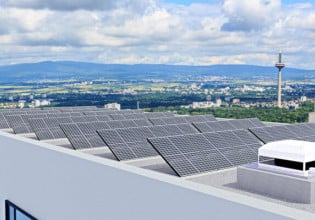The DC Power Partners of the Electric Power Research Institute (EPRI) and Lawrence Berkeley National Laboratory (LBNL) were well represented at the Darnell’s Green Building Power Forum. Members gathered from Asia, Europe and across the U.S. to present papers and discuss the latest developments in high-voltage dc power for data centers. Among the key presentations were papers from Anderson Power Components, Intel, Emerson Network Power, NetPower Labs AB, and NTT Facilities.
One of the most significant advances was announced by Brian Davies, Director of Engineering with Anderson Power Products who described the "Development of a DC Appliance Connector for Telecommunications Equipment." Standardized connectors are one of the few remaining missing elements that will enable wide-spread adoption of high-voltage DC in data centers. Davies presented a connector design that meets the electrical performance and testing standards were coordinated with CENELEC draft standard for a 400Vdc electrical plug and socket.
The resulting connector carries an IEC rating of 400Vdc, 20A. It is hot-plug rated for 250 cycles under full load. Under the UL/CSA rating system it achieves a voltage rating of 600Vdc with similar current and hot-plug cycle ratings. It features a dielectric withstand rating of 3kVdc and an operating temperature range of -20 to +90°C. The housing is mechanically identical to the IEC320-C14 ac-power connectors, enabling systems to be offered in either ac-input or dc-input versions with identical sheet metal.
Keizo Hoshijima, US Manager and Keiichi Hirose, Senior Research Manager with NTT Facilities presented a case-study of their, "Development of New DC Power Systems: Past, Today and Future." According to the authors, "Over 90% of the CO2 emissions of the NTT Group are from power consumption. Thus, in 1997 we launched a campaign called Total Power Revolution (TPR) in order to reduce our power consumption."
NTT’s TPR campaign promotes energy management at the company’s 4,000 buildings. The campaign has included efforts to introduce energy-efficient power and air-conditioning systems; convert servers, routers, and other IP equipment to use dc power in order to reduce power consumption; and improve energy self sufficiency through such clean sources of energy as solar and wind power systems.
As global warming becomes an increasingly hot issue, dc power has emerged as an extremely effective response for NTT. In June 2008, NTT Group announced officially it would implement a phased switch to DC supplies group wide NTT will aim at launching dc power demonstrations within fiscal 2009. Data centers will begin introducing 300V to 400Vdc supplies from 2010 by NTT Group. NTT Facilities, Inc. will conduct verification tests of the developed 400Vdc power system, protection system, engineering, and plug & socket keeping pace with the NTT group, which has been working on the promotion of direct current distribution, and aim to commercialize them by 2010.
In a related effort, Fujitsu Component Ltd and NTT Facilities developed a power bar and a power plug for 400Vdc distribution system. The two companies claim that they solved technical problems regarding arc discharge from open/closed-circuits, which has been preventing commercialization of high-voltage dc distribution in Japan. For safety reasons, the power plug incorporates a mechanical switch that prevents generation of voltage between power plug terminals unless loading apparatuses such as an ICT device is being used.
When connecting a load, the power plug is inserted into the outlet, and then the mechanical switch is slid to ON so as to close the internal contact. This mechanical switch allows workers and maintenance staff to plug and unplug it without any voltage being applied to it, realizing safer operation compared with existing 100V and 200V AC power systems, according to Fujitsu Component and NTT Facilities.
In addition, the power plug is equipped with functions for preventing wrong insertion and unintended unplugging due to tripping. Furthermore, the plug is equipped with an ark blocking module that uses high density magnetic force and forcibly extinguishes the arc when the mechanical switch is slid to OFF before pulling the plug out of the outlet. It consumes almost no power inside the outlet because it is not equipped with semiconductors or complex mechanical components, according to the companies. It is possible to achieve high reliability at low cost because of the small number of components.
BJ Sonnenberg, Business Development Manager with Emerson Network Power presented the benefits of PoE in a dc power distribution setting. According to Sonnerberg, efficiency, scalability and availability are among the key advantages of using a dc distribution system such as PoE. For example, compared with an ac-output UPS, a dc-output UPS can provide an 11% increase in system efficiency. Fewer components in the dc system also improve reliability and availability. Finally, the system is scalable and can be expanded as needed without any wiring changes or shutdown of the network.
During the Plenary session, Stefan Lidstrom, Chief Technology Officer with Netpower Labs AB focused on "Maximizing Overall Energy Efficiency in Data Centers." Also in the Plenary, Tomm Aldridge, Director of Intel’s Energy Systems Research Laboratory, described an in-depth case study conducted by Intel® Corporation in conjunction with EYP Mission Critical Facilities (an HP Company) and Emerson Network Power (more details on these Plenary talks can be found here ).
The GBPF closed with a special EPRI/LBNL DC Power Partners workshop. Over 50 delegates stayed an extra half-day to discuss the technology advances pointing to significant opportunities for certain dc-based applications, and promising benefits in terms of energy savings and increased reliability. And to review the many obstacles must be overcome. This workshop identified the current status and future plans for the development of dc power distribution including: business case considerations, safety factors, quantification of the energy savings and reliability benefits, standardization issues, and more.






